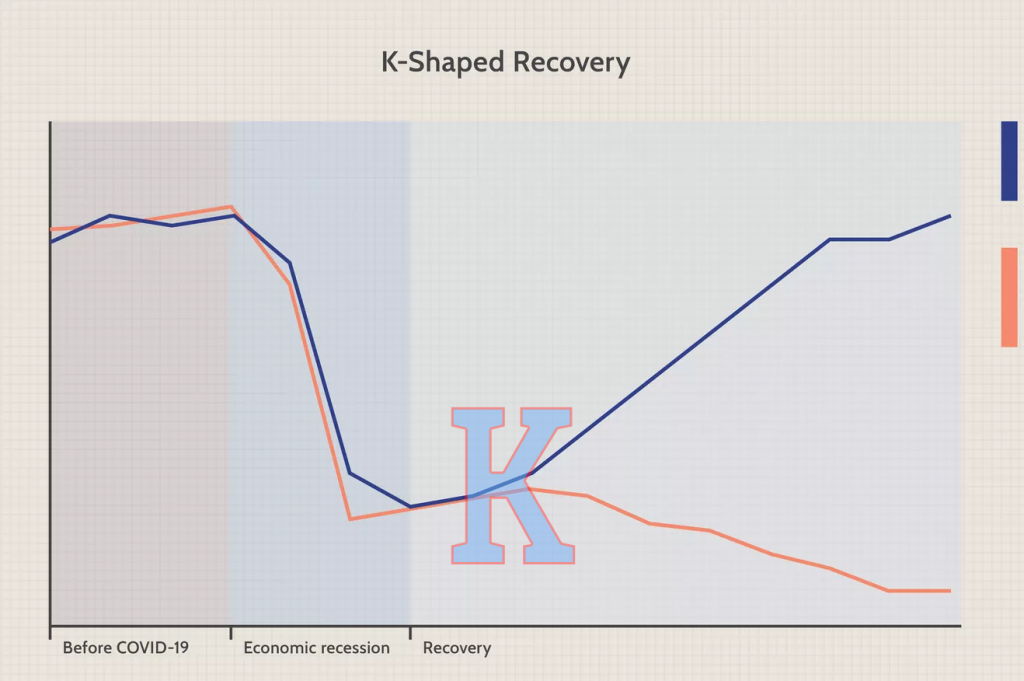Although Singapore has moved past its worst days in this pandemic-riddled period, the route to recovery is an uneven one. It is in the shape of a ‘K’.
Reader Bao: “K is an alphabet, not a shape.” If this is what you’re thinking right now, let me explain.
What is a K-shaped Recovery?
A K-shaped recovery means that one segment of the economy recovers while another part continues to suffer.

This uneven recovery could be described as “driving a car with two punctured wheels”, as said by Ms Selena Ling, head of treasury research and strategy at OCBC Bank.
The recovery pace is dependent on each sector.
The construction sector will recover moderately due to the restrictions they face.
The manufacturing, finance, and ICT (information and communications technology) sectors are regaining their momentum.
Travel-related sectors, however, such as aviation and tourism, will remain stagnant.
Budget 2021
Although there will not be a “big fiscal bazooka” this year, there will be continued support for targeted sectors such as the aviation and tourism industry.
Despite the government’s effort to boost tourism with the SingapoRediscover Vouchers, these sectors are still facing financial difficulties.
Chua Hak Bin, a senior economist at Maybank Kim Eng Research, expects the Jobs Support Scheme to extend for nine months in the sectors that are heavily affected by the pandemic.
That includes aviation, tourism-related industries, retail, and the arts and entertainment.
This extension would cost $2 billion.
GST Hike
Despite COVID-19, GST will be increased in Singapore.
This increase will take place when the economy is more stable. The targeted time frame is between 2021 and 2025.
Since the pandemic has taken up so much of the Government’s fiscal resources, it seems as if the GST hike might happen sooner rather than later.
Advertisements
Targeted Help for Individuals
Aside from offering targeted help for the different industries, there will be targeted help for different income groups as well.
The bottom 10 per cent of households in Singapore saw their average monthly income per member shrink by $37 in 2020.
DBS’ Mr Seah, believes that Budget 2021 can provide incentives for these groups of people as well.
Taking Advantage of the Crisis
For companies in sectors like healthcare, e-commerce and logistics, this crisis has allowed them to transform and digitise their services.
More locals across the skills ladder have been hired through job re-designing.
Advertisements
Furthermore, to promote sustainability, the Singapore Green Plan 2030 will be launched to encourage us to save the earth.
This sustainability agenda will be touched on more during the Budget process.
The Budget Process
In case you are wondering how Singapore’s finances are managed, here is a quick rundown of the budget process:
- April – Start of the new financial year
- Discussion within MOF (Ministry of Finance) and other agencies.
- December – Pre-budget Engagements
- Discussion is opened up for a wider public debate via various channels.
- Public feedback from these discussions will be gathered and reviewed.
- Cabinet approves the Budget
- February – Budget Statement
- Budget statement and Supply Bill are delivered and introduced by the Finance Minister.
- Parliament debates the budget statement.
- Round-Up Speech; Committee of Supply
- The round-up speech will be delivered. MP queries and main thrusts of the Budget will be clarified and summed up.
- Parliament will examine the plan for each ministry
- 2nd and 3rd Reading of Supply Bill
- Minister of Finance delivers the second and third reading of Supply Bill for the Parliament to vote.
- President’s Assent is Sought for Supply Bill
- If the President assents to the Supply Bill, the bill becomes a law called the Supply Act. This Act controls the Government’s finances in the upcoming Financial year.
- Supply Bill Enacted as Supply Act
Feature Image: Igor Plotnikov / Shutterstock.com
Read Also:
- 17YO Who Died in Tampines Accident Was a Promising Student; Dad Works in Police Coast Guard
- Trailer of Deadpool & Wolverine Dropped; Movie to be Released on 25 July
- 80 Earthquakes Hit Taiwan All Night, Swaying Buildings; No Casualties Reported Yet
- Names & Email Addresses of Parents & Staff from 127 MOE Schools Leaked After App Managing Students’ Devices Hacked
- 8 Highlights That Happened During Star Awards 2024 That You Might’ve Missed
Advertisements

